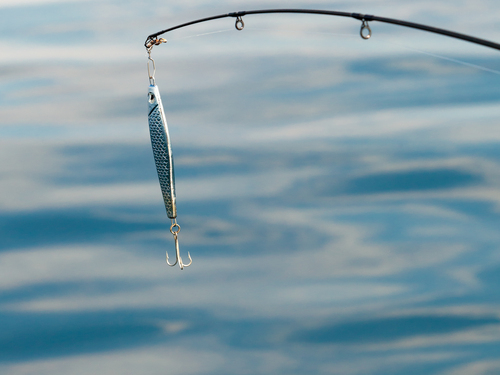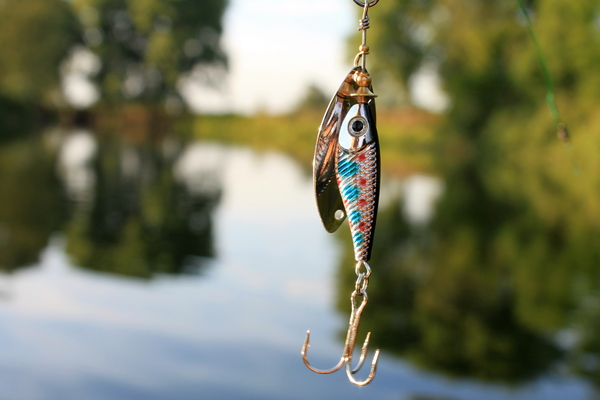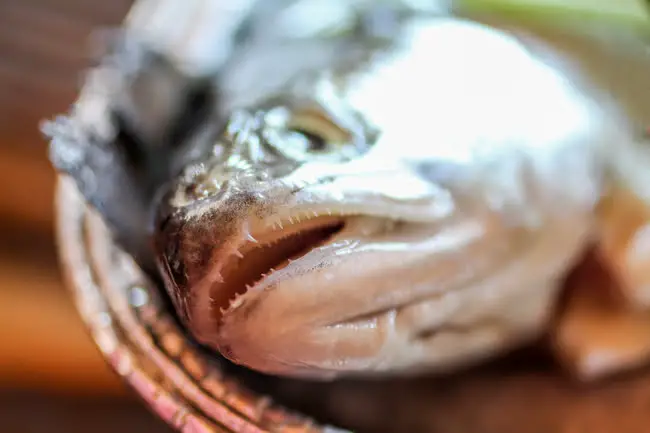If you are on the Eastern Seaboard and searching for one of the hardest and most consistently fighting fish to be caught, search no further than fishing for Bluefish.
In this article, we will cover 3 simple and effective bluefish rigs, and rigging tips used that almost every seasoned Bluefish angler utilizes to experience the best fishing.
Table of Contents
- Top Water And Float Rigs
- Jig and Spoon Rigs
- Fireball Rigs
- Options For Bluefish Rigs
- Common Rigging Factors
- Frequently Asked Questions
- Conclusion
Top Water And Float Rigs
By far the most bang for your buck when fishing for Bluefish in warmer waters is a top water/float rig. Bluefish are schooling fish that will fight to be the one in the school with the fullest stomach.
Rigging your live bait under a float will guarantee that you are keeping your bait or lure above the school and stationary in the strike zone. Your choice of a floating rig can range from a Popping Cork for added attraction, to just a plain bobber.

In the summer months up north, and year-round towards the waters surrounding Florida, the seawater is warm and provides an excellent sanctuary for Atlantic Bunker, mullet, and other larger baitfish to move near or inshore.
Bluefish run along shallow coastal waters following the bait, which is prime time fishing for anglers.
Jig and Spoon Rigs
With the added versatility of using both a jig and a spoon, the jig and spoon rig is the perfect mid-column lure for working faster-flowing currents or trolling where the Bluefish are actively chasing fleeing bait.
The depth of the rig will depend on the weight of the jig you attach, but generally, you will want to keep this rig off the bottom to keep you in the strike zone around larger schools of Bluefish.
A common rule of thumb for jig weights is:
- ¼ oz jigs- Sub-surface, especially in current.
- ½ oz jigs- 2-5 feet, depending on retrieve and current.
- ¾ oz jigs- 5-8 feet, good for moderate current.
- 1 oz jigs- 10-12 feet. Good for moderate surf, deeper water, and slow trolling.
- 2 oz jigs- 15-18 feet. Good for heavier surf, deeper water, and moderate trolling.
- 3+ oz jigs- These will guarantee you are working the bottom, or allow for a moderate to fast troll.
The best time to break out the jig and spoon rigs is when the waters are not yet at their warmest, and those topwater bites are not as frequent.
Giving these lures a consistent speed with the occasional quick pull will help fire up those Bluefish into feeding.
Fireball Rigs
When the waters are still on the colder side, or the schools of baitfish have not fully moved into an area, placing a Fireball Rig on the bottom is the easiest and most effective method for Bluefish.
The beauty of using a Fireball rig, if weighted appropriately for current and depth, is that you can use them regardless of the water conditions.
Fireball rigs work wonderfully in both flowing current and still water because their floats always keep your cut bait off the bottom.
Fireball rigs are a wonderful “cast and forget” rig for fishing.
It is less work than constantly focusing on a bobber, or working a jig and spoon rig. And the best part is, when you get bit, you will know without a doubt feel that ‘thump’ before leaning back and starting the fight.
See Also: Are Bluefish Good To Eat? Why The poor Reputation?
Options For Bluefish Rigs
Top Water And Float Rig Options
Topwater / Float rigs are as simplistic as they seem: Float, leader, and hook. This simplicity allows for quick rigging and easier fishing.
Just tie your main line to the top of the float, a 3-to-5-foot section of the leader to the bottom of the float, and your choice of hook or lure to the end of the leader.
The best part is, even with the numerous floats on the market, you can fish both live and artificial baits on them.
Jig and Spoon Rig Options

Jig and Spoon rigs are by far my favorite rig. There is a large assortment of both jigs and spoons to choose from, allowing you to mix and match the best and most lethal combinations for the areas you are fishing.
For this rig, you are going to want to select a jig that weighs more than your spoon.
If your spoon is heavier than your jig, regardless of leader length, your jig will risk twisting up your main leader. This is where a Clarks Spoon or diamond spoon are great options.
I like to tie my main line to a 3-way swivel. One of the loops will get around 2 to 3 feet of leader for the jig. This will give your mainline protection from the fish while ensuring separation from the spoon.
The last loop will have a leader that is up to you in length, but generally, I will put up to 6 or 7 feet of leader on it to still allow my castability. If you are out trolling, you can use up to 10 or 12 feet of leader to give more of a presentation in open water.
Fireball Rig Options
Fireball rigs are one of the more complicated rigs to tie. Fortunately for you, there is a wide selection of Fireball rigs, and styles like it, that are available on the market.
The biggest choice you will have when it comes to Fireball rigs is whether you want one that is made with a heavy mono or fluorocarbon leader or a thin metal wire.
Both serve their purposes; wire has a higher tensile strength while being able to rust, and mono or fluorocarbon is nearly invisible while being easier to fray.
Either way, you will want to choose a rig that comes with appropriate-size hooks for the type of cut bait that you wish to use.
Related: The 12 Best Bluefish Lures (& How To Fish Them!)
Common Rigging Factors
Rigging the rigs listed above fortunately comes with 2 common factors: the line and the leader.
Line Factors
A common weight range that will guarantee you land fish consistently, while allowing you to spool on enough line in case you hook a good runner, would be a 20-to-30-pound line.
A common mistake among new saltwater anglers is that they want the line weight to overly exceeds the fish weight. This common mistake results in a heavier line that does not allow for you to cast as far or always feel the bite.
Leader Factors
Your leader is where you will guarantee your catches. Leaning towards heavier fluorocarbon leaders with Bluefish is the smart move.
Additionally, some Bluefish anglers like to use a wire leader due to Bluefish’s sharp teeth.

Rigging, in most cases, should be a one-and-done task. To achieve this, I like to add a Quick Clip to the end of my leaders.
This allows for a buffer between the eyelet of the hook and the leader and allows me to change hooks, jigs, and spoons freely.
Frequently Asked Questions
There are so many types of swivels, which one should I use for bluefish?
One of the most common swivels used is a barrel swivel. A good rule of thumb is that the weight rating does not exceed your heaviest leader.
Why use metal leaders for bluefish?
Teeth! While you may intentionally be targeting Bluefish, they are not the only fish with sharp teeth. Oftentimes, Bluefish schools are followed by sharks who will eat their scraps and sometimes them.
Can I use live bait for Bluefish?
Bluefish, like many other predatory saltwater fish, will never pass up an opportunity for live bait. Live mullet, pilchards, pinfish and shrimp are your best choice.
Do I need a leader when fishing for Bluefish?
It is strongly recommended that you use one. Some places like BassPro will spool reels for free with your choice of monofilament line, but that line still has the potential to break even if you get a thicker line.
Conclusion
Bluefish fishing is one of the easiest and most rewarding opportunities to be had in the saltwater fishing world.
If you are willing to do some walking with a fishing rod and some tackle to your nearest beach or jetty when the season is right, you can easily have a day of consistent fishing.
You don’t even have to get on a boat to successfully fish for bluefish. It is usually just as easy to fish from the shore!
Hopefully, this guide will give you a good start to your Bluefish adventures, and hopefully a lifelong obsession for chasing those feeding schools!

Growing up in Florida, I’ve been surrounded by saltwater my entire life…and I love sharing my passion with others.
To learn more about why I started Saltwater Mecca, visit the ABOUT page.
Thank you for reading this article. Browse around & have some fun!